#16: Click On This If You Wish To Learn Things About Mewses
Ed Jefferson is attempting to visit every Mews in Greater London. This week: Scouse graffiti, confusing papier mâché, and an imaginary George Harrison doing a poo.

No opening bit this week as I have written too much about the actual Mewses, apologies if you don’t read the Mews Letter for important Mews information but that’s not really my fault is it? Anyway, keep going it’s got swearing and idle threats.
The Mewses
#151 Wedgwood Mews, Westminster, W1D

The one thing everyone can agree on is that Wedgwood Mews is named after Josiah Wedgwood, an 18th century potter who became a pioneer in his field despite (or perhaps because of) a bout of smallpox leaving him with a dodgy leg that struggled to turn a wheel. Wedgwood devised numerous methods and processes to deliver products that looked like they should cost more than it actually took to make them, and the company he founded what became one of the largest ceramics manufacturers of the day. This wasn’t solely (or even mainly) down to the pottery itself - he also had a keen sense of how to flog it: he’s often credited with inventing everything from the illustrated catalogue to the money back guarantee to the travelling salesman1 - inventing is probably a bit strong, but he certainly knew how to use the tools available to full effect.
A key tactic was promoting the image that his stuff appealed to the great and good. It did appeal to them, but it was important to shout about that - when the Queen turned out to be a fan, he made it part of the brand, made sure everyone knew about it. 18th century influencer marketing, basically - “I hear the Earl of Stamford has one”. His showrooms were a key part of this - anyone who was anyone had to be seen browsing for a vase.
In 1774, the firm rented Portland House in Greek Street - using the front as a showroom, initially showing off a dinner service created for Catherine the Great of Russia, but they stuck around for a couple of decades afterward and the historical association has persisted - there’s a commemorative plaque on the building. And then there’s the Mews.
It says, right there, on the front of Portland House, ‘Wedgwood Mews, W1’, which has caused some confusion over the years - was the building itself called Wedgwood Mews? Or maybe Wedgwood Mews is the alley next to the sign? Even though the alley has ‘James Court’ printed above in much larger letters?
As far as I can discern, the name Wedgwood Mews was at some point given to the yard behind Portland House, which contained a number of buildings used for typical Soho things e.g. according to a newspaper at one time you could write in to an office here to buy cassettes of people accidentally saying rude words on the radio, with the money going to a charity for the blind. For at least the latter years of its existence I suspect you had go through Portland House to access it, hence the somewhat confusing signage.
Then: redevelopment. Portland House isn’t actually Portland House anymore - everything but the front wall was demolished and rebuilt, including the Mews. There is still a courtyard behind, but the Wedgwood name apparently doesn’t carry much cachet any more, hence: James Court, home to various restaurants including the for some reason deeply unappetising sounding ‘Milk Beach’ (I know it probably doesn’t involve drinking milk on a beach2, and I guess there’s nothing wrong with drinking milk on a beach anyway, but there’s some viscerally unpleasant about the combination of words.) But as long as the sign exists, it will always be Wedgwood Mews to me, so I’m counting it.
#152 Richmond Mews, Westminster, W1D

From 1964 to the late 1980s 12 Wardour Street was home to the Marquee Club, a venue played by more or less anyone you might have heard of - Bowie, Hendrix, Pink Floyd, Metallica, Splodgenessabounds, etc. As the rear entrance to the club was on the Mews (an associated recording studio was here, too), we are free to imagine that it may have been the site of any amount of rock star style excessive behaviour. See that Biffa bin? That could have been where George Harrison done a poo while recording a Christmas record for The Beatles fan club.
Now home to wanky flats, wanky property developers, wanky agencies, and surprising amount of graffiti about how great Liverpool is (George, that you again?).
#153 Royalty Mews, Westminster, W1D
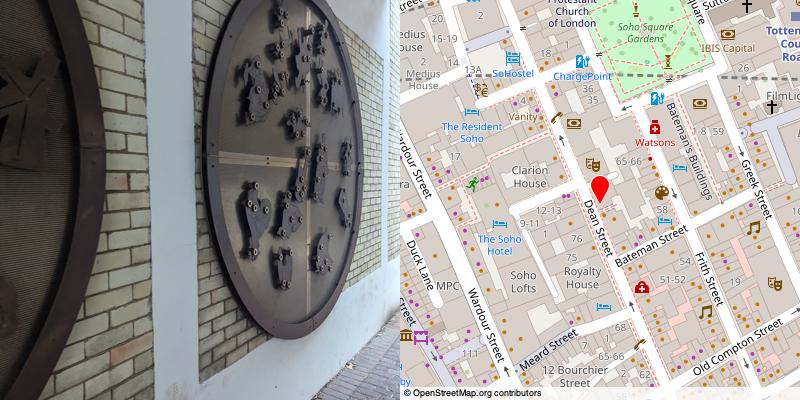
Royalty House, an office block on the other side of Dean Street, was built on the site of what for many years had been a theatre, mostly called either the Royalty Theatre or the New Royalty Theatre, which managed to survive for a century despite the repeated insistence of various officials that it was a massive fire risk. Though the film industry no doubt did much indirect harm to many theatres, in this case it was rather more straightforward: the Royalty was finally shut down in 1938 because the amount of highly flammable celluloid stored in the surrounding buildings was, perhaps unfairly given who was there first, deemed one fire risk too many. Any case that the theatre was there first was shortly afterwards deemed moot with the assistance of the Luftwaffe.
The named had attached itself to the Mews by the end of the 19th century, when it was your standard ‘stables with a place for the horse bloke to live upstairs’ arrangement - now it is standard ‘redeveloped apartments for the obscenely rich’. The various marketing bumph about the development is keen to emphasise that the exciting historical detail that there was once a recording studio here, dropping names that if you read carefully, are only mentioned as recording in the area rather than here specifically. The architects responsible tell us:
‘When designing Royalty Mews, [the architects] conceptualized a “muse” who would live, work and play in the space.’
Why not “fuck off“?
#154 Falconberg Mews, Westminster, W1D

This originally ran behind Falconberg House, the home of Thomas, the first Earl Fauconberg who I guess wasn’t sure how to spell his own name? Surroundings drastically reconfigured by the Crossrail project which saw the much-lamented demise of the Astoria music venue and the alternative gay club Ghetto. Instead we now have a rather literally shiny new theatre called “@sohoplace”. #relevant!
#155 Wardour Mews, Westminster, W1F
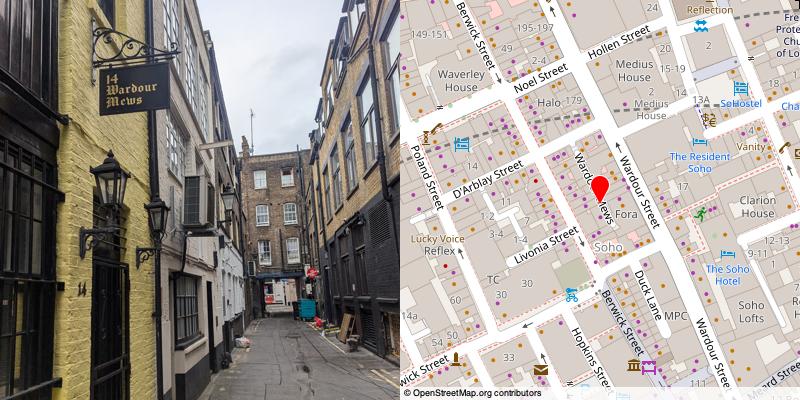
“i often think that if walls could talk wardour mews would have the very best of tawdry tales to tell !” offers a comment on a blog post listing old Soho nightclubs, and you do sort of get that feeling standing in it, like the gentrification is stretched a bit thin and you might accidentally stumble into some somehow extant ‘60s den of iniquity.
The late Rev Kenneth Leech said he founded homelessness charity Centrepoint after witnessing a police raid on the then notorious Limbo Club, which as responses to a venue go does beat a one star review on TripAdvisor I suppose.
(Also, I didn’t notice it at the time, but when double checking something on Google Streetview I noticed it has more of the pro-Liverpool graffiti I saw in Richmond Mews. Someone had a lovely day out in Soho!)
#156 Portland Mews, Westminster, W1F
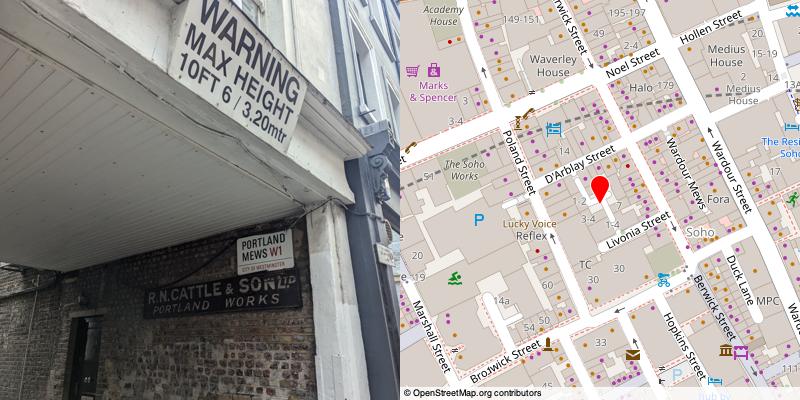
About 10 years ago, Hazuan Hashim and Phil Maxwell made a film following longtime Soho resident Harvey Gould around various bits of the area, including Portland Mews - which, as well as being the former home of a woodworking business called ‘R N Cattle & Son’ was also used by a much younger Harvey and chums to play cricket in the 1940s. In the film points out that you can see the remnants of painted cricket stumps on a wall, and checking my photos they’re still there, albeit that you do have to know what you’re looking for.
They had a somewhat unique scoring system: a ball that hit the first floor of the building opposite was a 4 - if it reached the second floor, that was a 6. Gould does not mention what happened if it hit one of several fairly prominent windows: possibly the game just ended and you all got to practise running very quickly.
#157 Wells Mews, Westminster, W1T
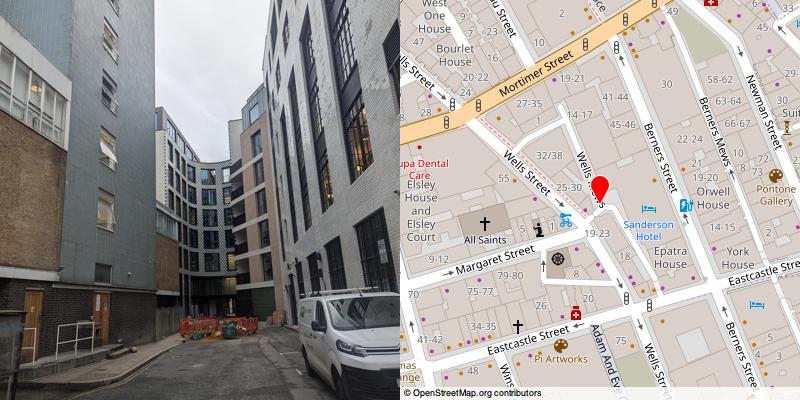
Once home to a celebrated ‘barrel-filer’ called Mr Evans, according to an. 1846 publication titled Instructions to Young Sportsmen: In All that Relates to Guns and Shooting. Now home to a “wellness-focused flexible workspace”. Evans, file my barrel.
#158 Berners Mews, Westminster, W1T

In the late 1700s, one of the houses that backed onto the Mews was owned by Somerset House architect William Chambers, who apparently decorated the rear in ‘fanciful’ papier mâché, and… hang on, papier mâché. In British weather? How long did that last? Am I missing something?
#159 Clipstone Mews, Westminster, W1W
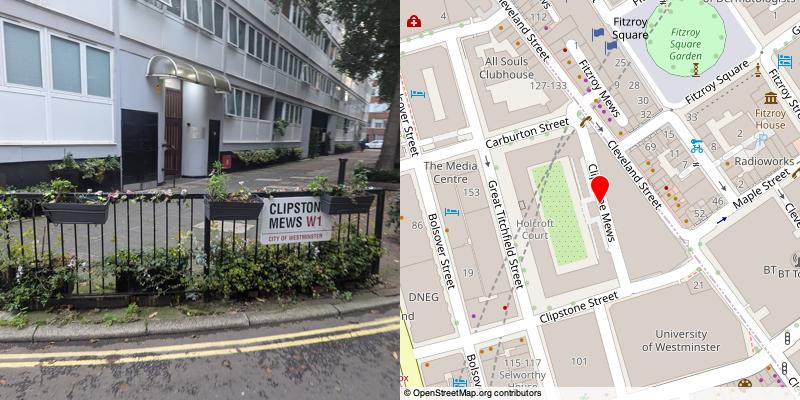
A relatively recent addition to the area - the street layout was shifted when Holcroft Court, a large block of council housing (the one of any scale in the vicinity), was built in the late 1960s, and Clipstone Mews replaced part of Hansom Street that was now under the apartment block.
The Mews features in a story in a self-published autobiography by a traffic warden - he attempts to ticket some bikers and they throw their Chinese food at his face. “All in all, this book is highly entertaining that will make you laugh and understand some traffic wardens.”, says the blurb.
In other traffic-related news, the Mews was home last petrol station in central London/the congestion charge zone until it was closed in 20133 due to the ongoing WAR on the HONEST MOTORIST who just wants to drive their car wherever they like, and have sex with it.
#160 Devonshire Row Mews, Westminster, W1B

There has recently been a proposal to convert the buildings on the western side of this Mews (currently garages) into some sort of medical clinic: doing what, I’m not sure, but given the area probably something expensive!
The planning documentation for this alerted me to the existence of the Portland Village Association, which campaigns to keep Portland Village - by which they mean ‘the bit between Marylebone and Fitzrovia’ - "a wonderful place to live, work, and visit". I mean, there are very few places in London that can be referred to as ‘[x] village’ without being quite annoying and stupid, but in the West End? Hopefully this new clinic will offer some sort of head examination service.
Mewses Visited Thus Far: 160/2380
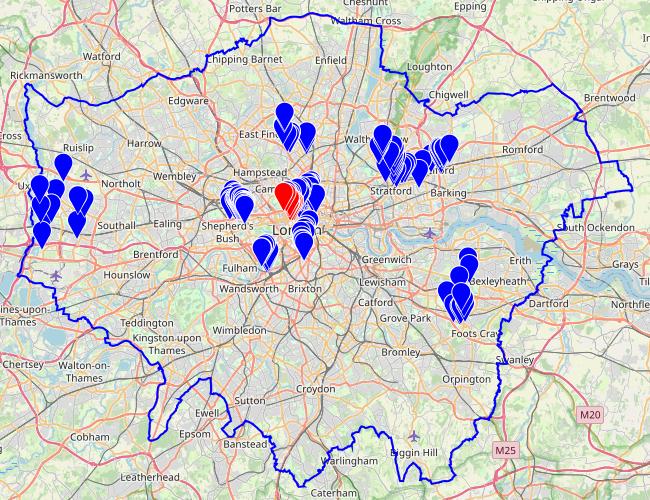
I’m particularly dubious of a claim that he invented the ‘Buy One Get One Free’ offer, which is slightly too cute as a detail. Certainly none of the biographies I’ve checked appear to mention it, and he seems to typically have been price conscious in the other direction - i.e. it was important to him that the products didn’t seem too cheap. ↩
It’s an Australian restaurant, whatever that means, and there’s apparently a beach called that in Australia, wherever that is. ↩
A nearby replacement was mooted but did not in the end appear, due to woke, I expect. ↩
Add a comment: